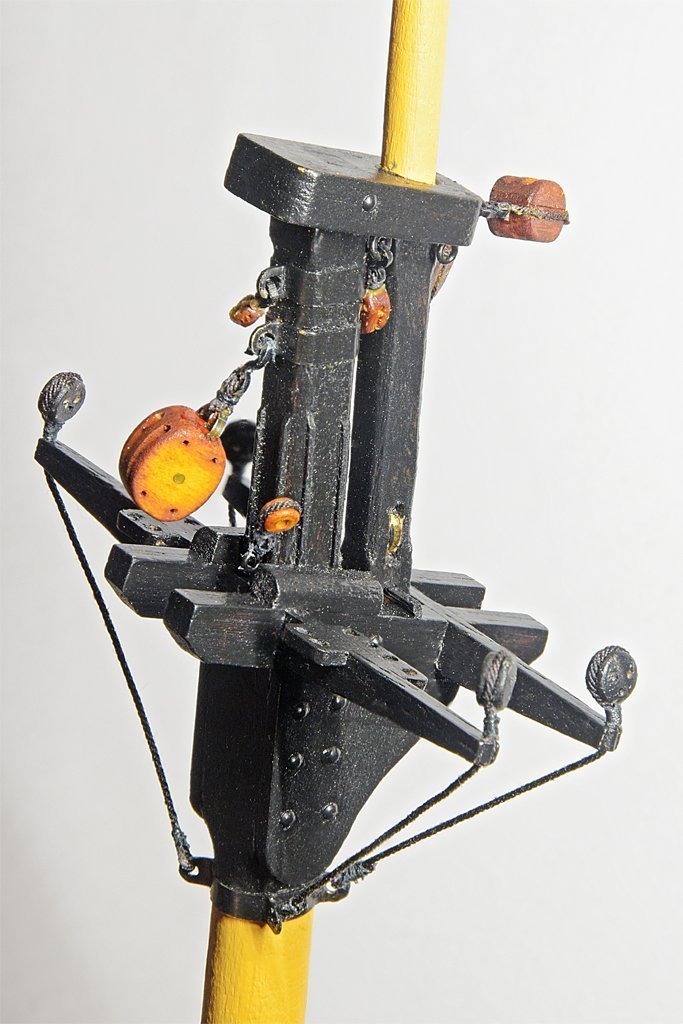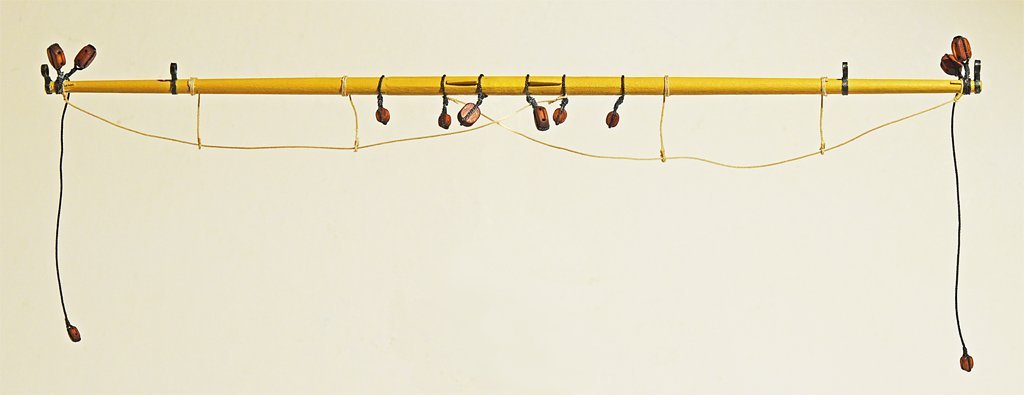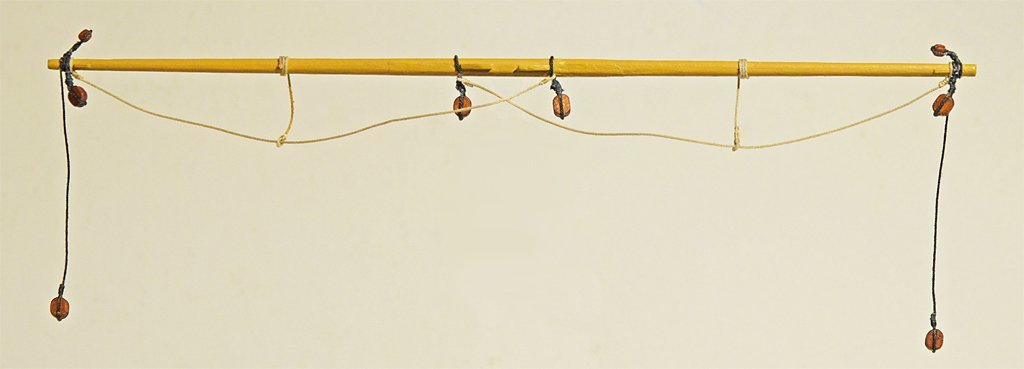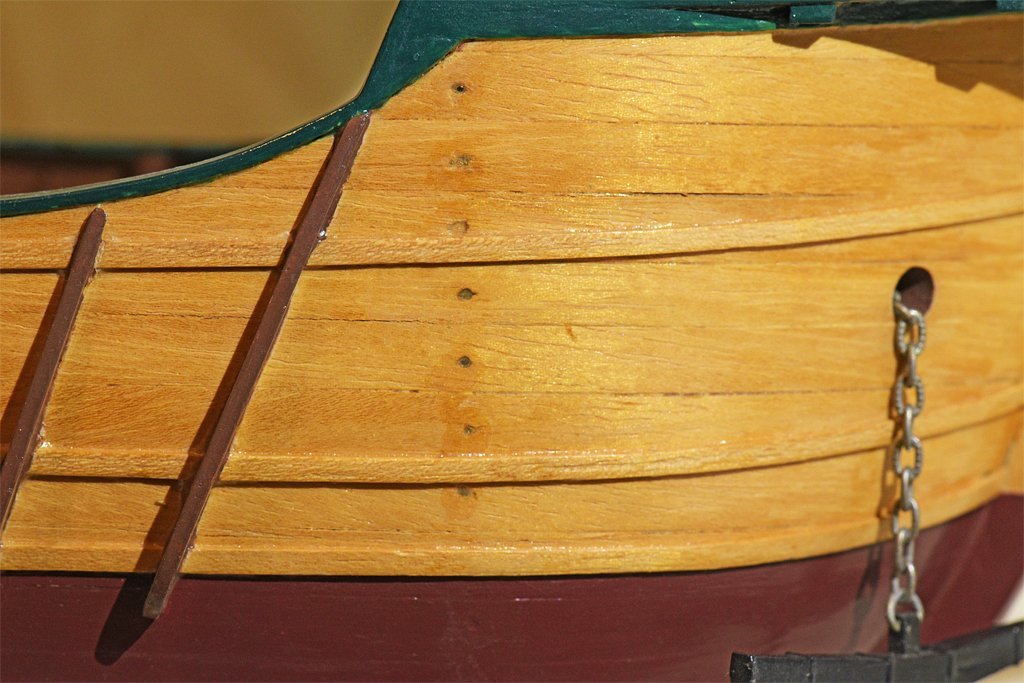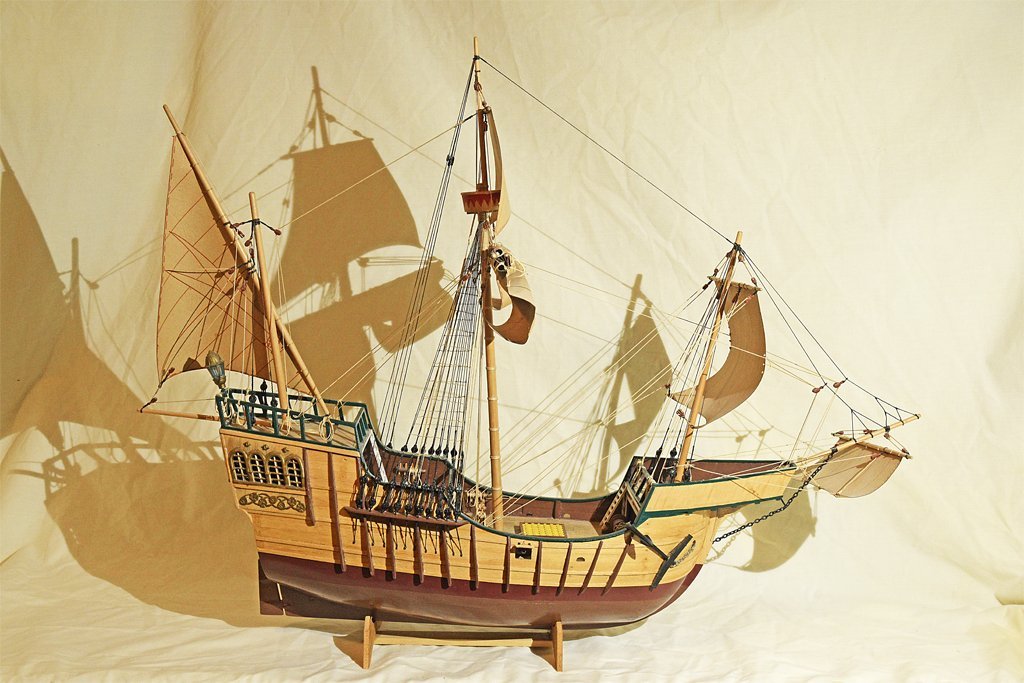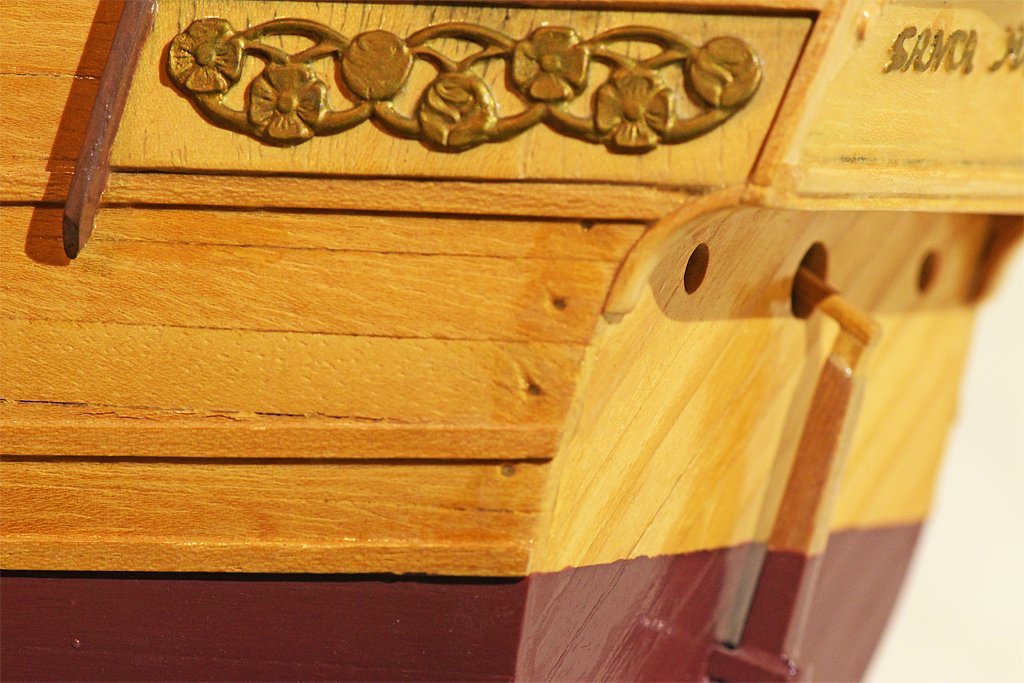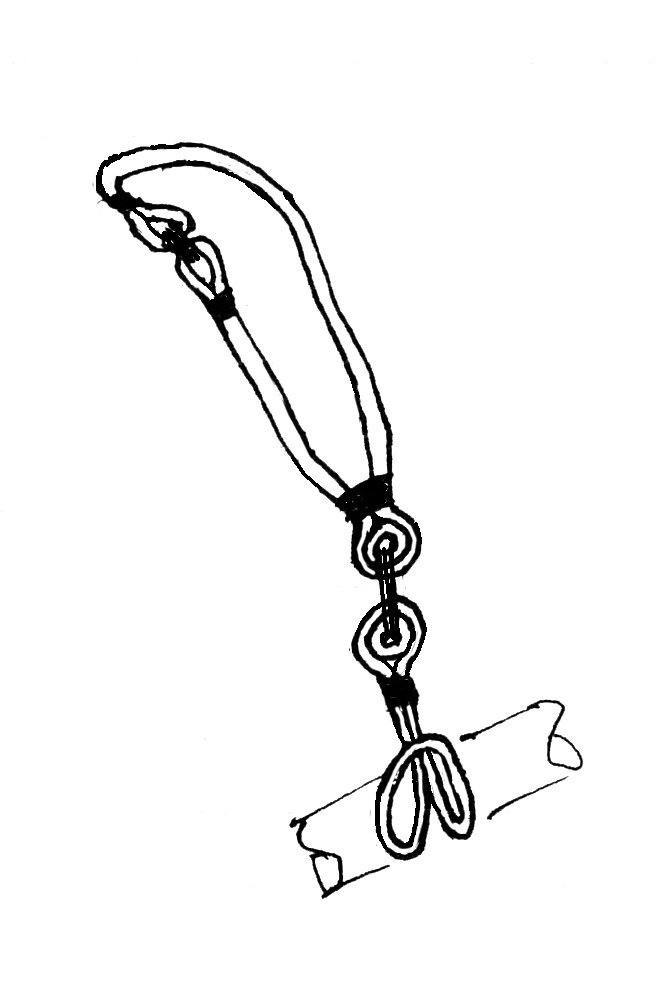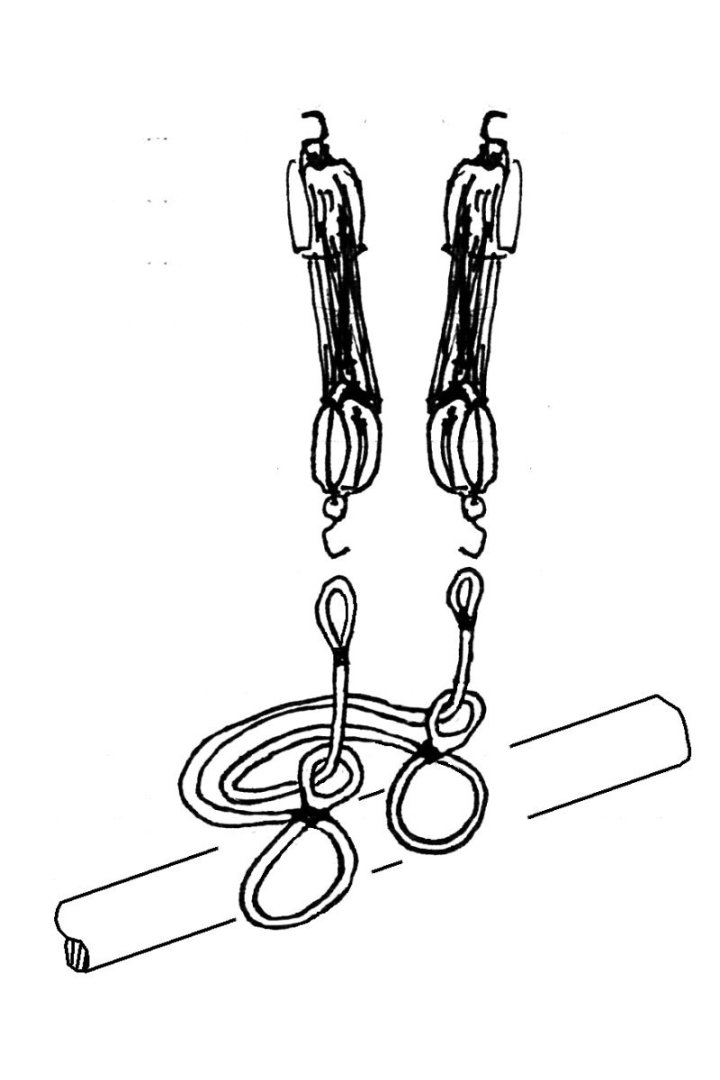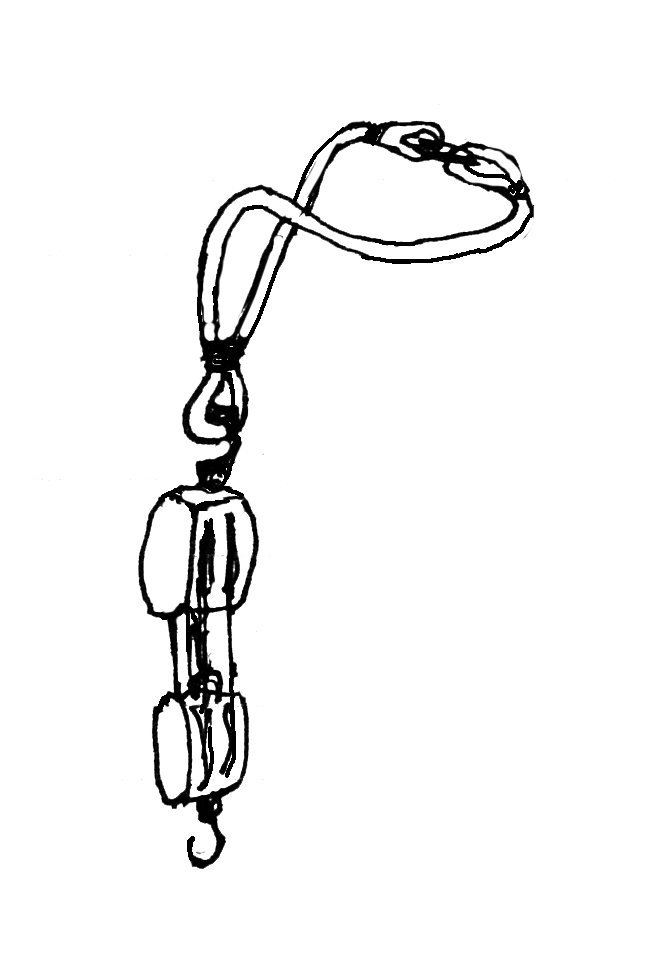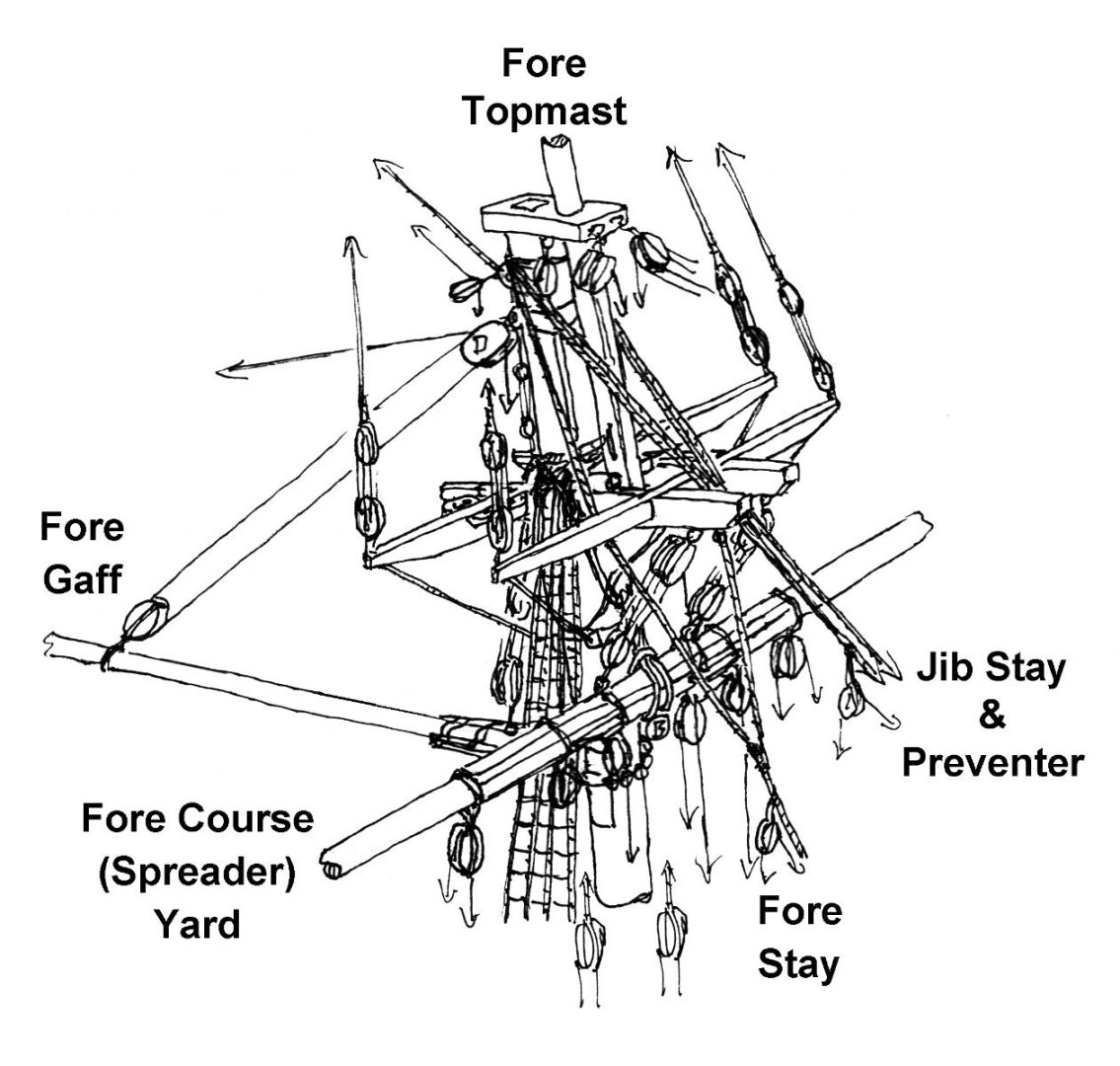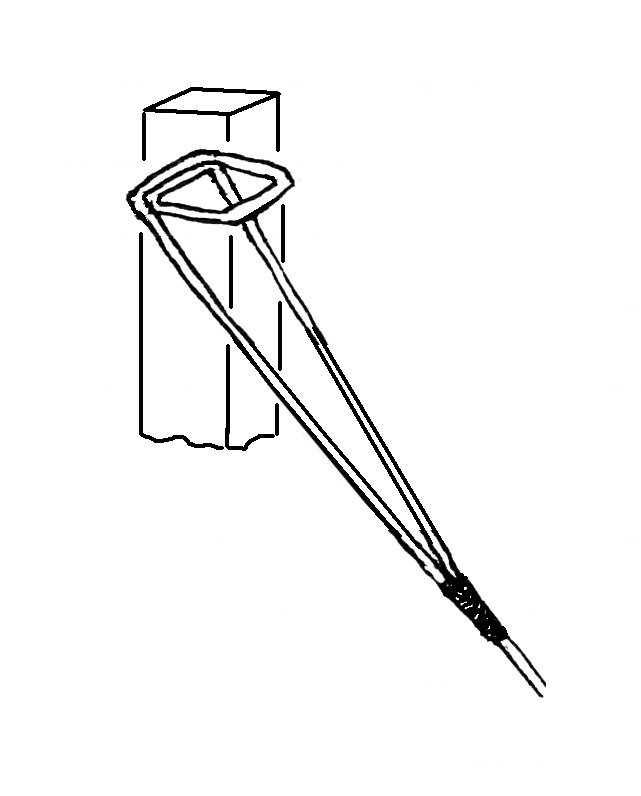-
Posts
2,458 -
Joined
-
Last visited
Content Type
Profiles
Forums
Gallery
Events
Everything posted by Dr PR
-
Allan, I am fairly new to the study of sailing ship rigging, having started on a topsail schooner about five years ago. But one thing I have discovered is that it is probable that no two ships were ever rigged the same way! So Lees (Lever, Marquardt, zu Mondfeld, Chapelle, McGregor, Peterson, Underhill, Biddlecomb, Steel ...) may show the way a particular ship was rigged, but that doesn't mean every ship was rigged that way! There is only one rule that I have discerned that applies to every ship - a line must not foul other lines, spars, masts, etc., and when possible it should be routed so it doesn't chafe against other parts. Given this rule you have to attach lines and blocks wherever necessary and find a place to belay them to clear as much of the other rigging as possible. I suspect it was the Captain, Mate or Bosun who decided how things were rigged on their ships, and that might change with time and experience. There are some general trends for belaying that I have found: 1. Lines that originate lower down in the rigging generally belay forward on pin rails, fife rails and cleats. Lines from higher points belay farther aft. 2. Lines descending from near the mast belay near the bottom of the mast (partners). Lines descending from yard arms belay along the bulwarks or deck edges. 3. An exception to 2 is that lines from very high in the rigging, whether from yard arms or from near the mast, may belay along the bulwarks or near deck edges. The prime rule is that lines must not foul other lines. They may be led through fairleads on crosstrees or the bowsprit, through thimbles/trucks on shrouds, or running blocks attached where necessary to lead them around obstacles. How all of this is accomplished depends upon the configuration of the masts, spars and rigging on the particular vessel. For example, I have found three different ways the fore course (spreader) yard braces were routed on topsail schooners, and there may well be other ways. Perhaps the most frustrating thing I have encountered is that almost every "authority" I have read that describes ship's rigging says for every line that it was "belayed below" or "on deck." Very few books show where the lines were belayed "below." I eventually figured out that this is because no two ships were rigged the same. So unless you have the original rigging and belaying plan for a particular ship you are pretty much on your own to figure it out for yourself!
-

Brig USS Enterprise 1799 info gathering
Dr PR replied to CharlieZardoz's topic in Nautical/Naval History
Has anything come of the drawing Geoffrey Footner found in the archives of the Arsenal of Venice believed to of Enterprize? Is is actually a drawing of that vessel? -
Melissa, I have a Paasch airbrush set (VL-SET) that I got 20-30 years ago. It has a VL double action airbrush - push the button down to increase/decrease the airflow and forward/back to control the amount of paint. This "double action" allows very good control of the amount of paint you apply, and you can shut off the paint and just use it as an air supply to blow dry the paint. I don't remember what I paid for it back then, but it has been worth the money for all the painting options it allows. I see it for under $80 on Amazon (less the 3 ounce bottle). It came with three needle/nozzle sets for fine (narrow), medium and heavy (wide) paint application. This is good for painting small parts or larger surfaces like hulls. It has a paint cup for small amounts of paint and two bottles (1 and 3 ounce) for larger paint jobs (but not large enough to paint your house if you are in a hurry). **** The air compressor and regulator are as important as the airbrush. Be sure you can adjust the pressure to the 20-30 psi range. An air tank on the compressor output is good because it will absorb some of the pressure pulsations from the compressor and collect moisture from the cooling compressed air. Just about anything you can find that meets these requirements will work.
-
Here is a bit of trivia for you: In 1980 I started working for a company that had the contract for automating plywood lathes from the company that owned the patent. We supplied the computers and software to peel veneer from logs. By the mid '80s nearly all of the plywood lathes in North America were operated by a small (6" x 6" x 6.5") multiprocessor computer I designed. If you used plywood in North America from 1985 through to about 2000 the veneer was probably produced by that small computer. It was a fun project! https://ao-cs.com/Projects/little computer project.html
-
Another bit about rivets as a reference to putting them on models. On the Cleveland class cruisers of WWII that I am familiar with. Below the water line rivet heads were to be "as nearly flush as possible." The leading edges of hull plates of different thicknesses were chamfered by grinding to about 45 degrees. Backing plates were inside the hull plating. Quite a bit of effort was made to reduce drag. Above the water line backing plates were outside the hull plating. Rivet heads were visible if you were standing close to them, but had very slight height above the plating and slightly conical. This was also true of the rivets on the turrets. None of the riveting would be noticeable from more than a few yards/meters distant. There is no reason to put them on models. I don't know how many decades this type of riveting goes back before the 1930s, but at some point builders began taking steps to reduce underwater drag.
-
Per and John, I call myself a frustrated perfectionist. Although my goal is always perfection I have yet to achieve it. Maybe because I think achieving perfection is impossible! But it doesn't hurt to try. My primary goal with this build was to learn about topsail schooners, and I am doing that! Almost all modeling information (spar dimensions, rope sizes, etc.) is for larger square rigged ships. I have encountered "surprises" several times, like the difference in gaff halliard size calculations for ships and schooners, or mast diameter calculations. And in the end I learn about both schooners and ships! Unfortunately, John, this model isn't historically accurate. I made mistakes when I first constructed the hull decades ago, and additional mistakes when I started up again five years ago this month. At least some of the details are probably historically accurate. But I have enjoyed the build immensely - and I am learning!
-
I have run into another problem with dimensions of parts for schooners versus large square rigged ships. My initial calculations for the size of the blocks for the gaff peak halliard and throat halliard was 5/16 inch (8 mm). I have calculated this using formulas from several authors and they all say the same thing. But look at this photo. The 8 mm peak halliard block hanging from the band on the mast is ridiculously large. Its height is about the same as the diameter of the mast. I have looked at a number of period models and recent kits, and none have blocks this huge! I think my calculations are just wrong! According to several sources the fore stay circumference is 1/2 the mast diameter (0.350 inch, 8.9 mm), or 0.175 inch (4.4 mm). The halliard size is 1/2 the fore stay size, or a circumference of 0.088 inch (2.2 mm) and diameter of 0.028 inch (0.7 mm). So far all sources agree. I will use 0.025 inch (0.0635 mm) rope. But the block size is supposed to be about 12.6 times the rope diameter (4 x circumference), or 5/16 inch (8 mm). The block in the photo is an 8 mm block! Lees Masting and Rigging says the height of blocks should be about 4x the rope circumference. The circumference is 0.088 inch, so the block should be 4 x 0.088 inch = 0.352 inch or (8.9 mm). This is even larger that what I have used!! To look at it another way, for a 1:48 model 0.352 x 48 = 16.9 inches. Or 5/16 inch x 48 = 15 inches. Both seem too large. These calculations are all for large square rigged ships of the line, but schooners have lighter tophamper than square riggers. Marquardt's The Global Schooner says the schooner throat halliard size is 0.4 x (not 0.5 x) the main stay circumference, or 0.175 x 0.4 = 0.07 inch (1.7 mm). This would give a block size about 0.28 inches (7.1 mm). 0.28 x 48 = 13.44 inches. This is a lot closer to the 14 inch blocks listed in Marquardt's tables for many American schooners' peak and throat halliards. 14/48 = 0.29 inch (7.4 mm). I think I will use 7 mm blocks for the gaff halliards. I have ordered some 7 mm single and double blocks. I'll have to stain them to match the other blocks, and then I can get on with rigging the gaffs.
-
Beautiful model! I have liked the lines of this ship ever since I saw drawings of it in Chapelle's The Baltimore Clipper.
- 106 replies
-
- Grecian
- baltimore clipper
-
(and 4 more)
Tagged with:
-
A little progress. I have rigged the yards for the fore mast. Fore course yard. Some topsail schooners carry a simpler spreader yard for the topsail, but I have rigged this yard so it can carry the large square fore course sail. The upper blocks on the yardarms are for the fore course yard lifts and the topsail sheets. The brace pendants hang from the yardarms. The larger blocks at the center inside the sling cleats are for the topsail sheets. At the outboard ends of the sling cleats are the fore course clewline blocks. Farther out are blocks for fore course buntlines. The yard sling and trusses will be at the center between the sling cleats. Normally the vessel would have raised just the fore staysail. But in good wind from astern the fore course could be raised. These two sails occupy some of the the same space forward of the fore mast so they wouldn't have been raised at the same time. The yard also has irons for studding sails. Fore topsail yard. The lower blocks on yardarms are for studding sail halliards. The upper blocks are for the topsail yard lifts, and the blocks near the center of the yard are for the topsail clewlines. The brace pendants hang from the yardarms. Now I need to "train" the footropes (horses) to hang naturally with some shellac and weights. Some of this rigging would have been very difficult if the yard was mounted on the mast, and with the mast mounted on the hull.
-

Who uses nails?
Dr PR replied to bigcreekdad's topic in Building, Framing, Planking and plating a ships hull and deck
BCDad, Back in 1969 I built my first ship model kit, the Santa Maria by Billings Boats (I think). Before that I had built two scratch builds (a schooner and a Chris Craft motor yacht) before I knew there were such things as wooden ship model kits (or could afford one). The kit had tiny steel finishing nails, the instructions said to use them, and I did. They were used to hold the hull planks in place on the bulkheads. I didn't like the looks of the metal heads so I countersunk the nails. Then I mixed a paste of wood dust and glue and filled in over the nail heads. It didn't work all that well. That was the only time I used nails for planking the hull. In all subsequent builds I glued the planks in place with wood model cement (like the Duco nitrocellulose in acetone glue). I used rubber bands and a bit of ingenuity to hold the planks in place until the glue dried (it sets in 20-30 seconds and hardens fully over night). I still use small brass nails like Barkeater does. -

drilling hole through wire
Dr PR replied to BETAQDAVE's topic in Metal Work, Soldering and Metal Fittings
Dave, I hope you get a good answer! I have tried 3D printing hand rails at 1:96 scale and they are so fragile that it seems that breathing heavily over then will break them! I need to work with 1.5 ", 1.25" and 1" outside diameter pipe railings. At 1:96 that is 0.016" (0.4 mm), 0.013" (0.33 mm) and 0.010" ((0.26 mm) brass wire. Drilling a 0.013" hole in0.016" wire will require a milling machine with very little runout, and a very accurate table positioning setup (and a tremendous amount of patience). I think Sherline makes a machine that might work. -
I have one of those two-arm gadgets with the magnifier. The magnifier is almost useless! It actually gets in the way of seeing things. Get a magnifying visor! The other thing to remember is that these things have CHEAP ball adjustments. They wear out quickly and cause problems setting the desired angles. Still, mine must be 20+ years old and I am still using it, although it can be quite annoying to work with. The screw clamps to hold the alligator clips crush the thin metal tubes of the alligators further adding to the frustration when trying to reposition them. I got my money's worth out of it, but there must be something better.
-
I am glad you are finishing Chaconia. I love all the piping and cables on that model. You mention the "pose" of the fellow in the photos. It is mostly accidental. More "whatever happens" than "pose." That thing has two small feet, but it will stand up on its own if the surface is horizontal (perpendicular to the Earth's gravitational attraction). However, the vessel's deck has camber, so the figure only wants to stand up on the centerline. To resolve this I cheat - I tilt the model slightly until the figure stands where I want it, and tilt the camera (picture) to compensate. PITA! I have resorted to a small patch of double sided tape that is hidden by the bulwarks.
-

Focus Stacking
Dr PR replied to Dennis P Finegan's topic in Photographing your work. How to do this.
The phone won't work unless you can adjust the focus manually to set the depth of the focal points. I don't know if any cell phone camera has this capability. However, if it does it might have the automatic focus stacking feature. The macro lens on my cell phone has an EXTREMELY shallow depth of field (less than 1/8 inch (3 mm). It is essentially useless for anything but flat objects. I would have to take dozens (hundreds?) of images at different focus depths to get a set of photos of my ship model for photo stacking. I can get an 11" (280 mm) depth of field with the real macro lens on my DSLR. You can probably get better photos for focus stacking with the ordinary camera in your cell phone. -

Stepping the mast with a plum bob...two questions.
Dr PR replied to HardeeHarHar's topic in Masting, rigging and sails
DO NOT GLUE THE MASTS IN PLACE! After the shrouds and stays are added the masts cannot go anywhere. Careful about using the "waterline level" idea. This assumes the waterline is actually in the correct position. If for some reason it is a bit lower on one side than the other,and you "level" the waterline, then your mast will not be perpendicular to the deck (from side to side) and this will be VERY obvious when you look at the model. You want to get the deck level - as John Ruy shows in his photos. If the model has bulwarks, and IF your bulwark cap rails are the same height above the deck on either side of the mast, you can use the tops of the rails as a reference and level them. I place something across the bulwarks and behind the mast as my horizontal reference. Then I use an ordinary right angle drafting square placed on the horizontal piece to align the mast. This method does not require the hull to be "level" in any orientation. The mast is positioned relative to the hull, and not relative to the Earth. The plum bob will work IFF your deck is horizontal relative to the Earth - hence the spirit level in John's photo. **** It is a bit late to be thinking about stepping the masts when you get to the point you want to start rigging. That should have been done while the hull and deck were being constructed. I show a technique in this post for setting the fore-aft rake and positioning the mast vertical port-starboard. https://modelshipworld.com/topic/19611-albatros-by-dr-pr-mantua-scale-148-revenue-cutter-kitbash-about-1815/?do=findComment&comment=599087 I am just getting to the point I want to step the masts and start rigging. When I temporarily install the masts they are still perfectly vertical and have the desired rake. However, experience tells me that I can bend the masts from side to side while installing the shrouds and stays. So I will have to be careful and used the actual procedure for installing them, starting on the starboard side for one line/set, then on the port side for the next, back to starboard for the third, etc. The first few stays and shrouds are important. After you get them rigged without bending the mast they will stiffen the structure and resist further bending. BUT IF YOU SET THE SHROUDS/STAYS TO BEND THE MAST YOU WILL HAVE TO REMOVE THEM ALL AND START OVER. -
Javelin, That curse of details is so true! I was designing a 3D CAD model of a winch, and put in all the bolts and such. But close up photos clearly showed the manufacturer's name cast into the gear case. Should I model that also? The letters were cast with compound curve surfaces, and those are tricky to model. I could do it - I have modeled worse - but would take longer to do that the rest of the winch. Well, the letters were about 0.25 inch (6 mm) high and 0.25 inch wide. If printed at 1:100 scale they would be 0.0025" (0.06 mm) high and 0.0025" wide. There was no way that was going to come out legible, even with a magnifier! So why bother? You have to set a minimum size that you will try to model and skip the details smaller than that.
-
Ouch! And ouch again!! I definitely would have had a panic moment when the crosstree broke! In previous builds I breathed a sign of relief when all the lower shrouds were in, the masts were vertical, and the upper deadeyes all lined up evenly spaced.
- 282 replies
-
- Bluenose
- Model Shipways
-
(and 1 more)
Tagged with:
-
I have been working on the fore course yard (spreader yard) and the fore topsail yard. For this I had to determine the position and types of rigging on each for rigging them to the fore mast before I install them. This lead to some problems trying to determine where all of the rigging should go on the fore mast, especially at the top. This sketch shows how much of this rigging is crowded around the fore top. I count 23 blocks in the drawing on 30 lines, and there are 10 more lines that come down from the topsail and yard above and pass through fairleads on the aft crosstree on the way to the base of the mast! The fore stay, jib stay and preventer created problems. These lines are normally shown looping around the lower mast just above the bolster on the trestletrees, lying over the shrouds. The lines would then lead down over the cheeks and would be seized together (or moused) in front of the mast. But because of the rake of the mast this would cause the forestay to rest on the fore course yard or very close to it. The jib stay and preventer would run in a similar way and could interfere with the truss tackle below the trestletrees. It was all very crowded around the fore course yard. I looked through Chapelle's "The Baltimore Clipper" and Marquardt's "The Global Schooner" to see if there were any examples where these stays were routed another way. I found six examples dating back into the late 1700s where the stays were looped behind the lower mast higher up in the head, and even looped over the top cap. (Millbrook 1797, Flying Fish 1806, Experiment 1812, Hornet 1831, Santiago 1833 and Vigilant 1848) There were cleats attached to the aft side of the mast to support the stays, and in some cases lashings around the masts. I plan to loop the stays around the mast below the mast cap, just above the metal band for the main top stay. This way the fore stay will come down along the sides of the trestle trees behind the fore crosstree and will then be siezed together some distance in front of the fore course yard. The jib stay and preventer will come down between the trestletrees in front of the fore crosstree. The stays will not interfere with the other rigging in this area. There were several other rigging questions that I needed to answer before proceeding. The sling that supports the fore course yard loops around the top of the lower mast and lays on the shrouds. After studying several examples I decided to use the configuration shown. It is made up of two parts. The upper loop has a thimble seized in an eye above the spar. From this the two legs go up on either side of the cheeks. The shorter starboard leg has an eye spliced alongside the mast. The longer port leg wraps around behind the mast and has an eye spliced where it meets the starboard leg. These eyes are lashed together to complete the loop around the mast. The lower part is a loop with a thimble spliced into an eye at the upper part. The lower part is looped around the spar from the front and the bight brought up behind. The eye and thimble are pulled through the bight to close the loop. The loop passes between the sling cleats on the fore side of the yard near the center. The eyes of the two parts are lashed together to support the spar. This configuration can be rigged in two parts, one around the mast at the top and one around the spar. Then when the spar is hoisted up into place the parts can be lashed together. The fore gaff throat halliard has a similar strap to the upper part of the yard sling. It loops around the lower mast and is positioned over the yard sling with the eye and thimble hanging behind the mast and the two eyes lashed together on the port side. The upper double block of the halliard tackle has a hook that passes through the thimble on the strap. The lower block of the tackle has a hook that catches a ring bolt on the upper side of the boom jaws. The fore course yard trusses are somewhat speculative. Their function is to pull the yard back against the mast so it cannot swing while the vessel is rolling and pitching. When the yard is to be repositioned the trusses are loosened. Many smaller vessels do not have trusses so it was a question whether they are necessary. They certainly do add to the clutter in the mast hounds area. But while I was designing the fore course yard I discovered that the topsail schooners had a yard equal to or greater than for the square rigged ships. Both Fincham and Rankine (naval designers of the late 1700s and early 1800s) used formulas that produced extra long and heavy yards. So I decided that the trusses might be necessary - and they will be interesting to rig!. There are two ropes with eyes and thimbles at each end. One eye is laid on top of the yard with the rope looped behind and below the yard and back up and over. The parts are spliced together close to the eye on top of the yard. The other rope is looped around the yard in the same way. The loops are at the center of the yard between the sling cleats, on each side of the yard sling. Now the loose ends of the ropes are passed around behind the mast and then through the eye of the other rope and lead upwards. The second eye in each rope connects to the hook on a single sheave block. This is part of a luff tackle with the upper double block hooked to an eyebolt on the bottom of the trestletree. The fall of the tackle leads down and is belayed at the base of the mast. When the falls are tightened the tackle pulls the slack out of the truss loops to pull the yard against the mast. Prior to about 1810 the ropes led down to the deck after passing through the eyes (which were on the aft side of the yard). The luff tackle was hooked to eye bolts on deck. But after 1810 the truss tackle was rearranged as shown here. There were other truss arrangements, including one that used a single rope. That might be more appropriate on a small vessel.
-
I have the same problem. I started a kit in the mid 1980s. The plans were incomprehensible (for me). What few books I had said a lot about history and nothing about how ships were built. So I constructed the stern the way more modern vessels are built. This has bothered me, but I really don't care enough to try and "fix" it. I have discovered other errors in the build, and fixed a few. But I am kitbashing it into a hypothetical vessel anyway (everything from the deck up is scratch built). For me it is a learning experience, and I am enjoying the research to learn how these ships were built. Maybe my next build will be "perfect" but for now this imperfect one is good enough. So how much do you care if your Bellona model isn't perfect?
About us
Modelshipworld - Advancing Ship Modeling through Research
SSL Secured
Your security is important for us so this Website is SSL-Secured
NRG Mailing Address
Nautical Research Guild
237 South Lincoln Street
Westmont IL, 60559-1917
Model Ship World ® and the MSW logo are Registered Trademarks, and belong to the Nautical Research Guild (United States Patent and Trademark Office: No. 6,929,264 & No. 6,929,274, registered Dec. 20, 2022)
Helpful Links
About the NRG
If you enjoy building ship models that are historically accurate as well as beautiful, then The Nautical Research Guild (NRG) is just right for you.
The Guild is a non-profit educational organization whose mission is to “Advance Ship Modeling Through Research”. We provide support to our members in their efforts to raise the quality of their model ships.
The Nautical Research Guild has published our world-renowned quarterly magazine, The Nautical Research Journal, since 1955. The pages of the Journal are full of articles by accomplished ship modelers who show you how they create those exquisite details on their models, and by maritime historians who show you the correct details to build. The Journal is available in both print and digital editions. Go to the NRG web site (www.thenrg.org) to download a complimentary digital copy of the Journal. The NRG also publishes plan sets, books and compilations of back issues of the Journal and the former Ships in Scale and Model Ship Builder magazines.





